According to the legend, Awaji is the first island in the world, created by gods Izanagi and Izanami, brother and sister, with their “Heavenly Jewelled Spear”. From their “Olympus”, the mixed the primordial broth in which the Earth was immersed and by pulling up the spear, they left a drop fall from above, which by falling back on the planet created Awaji.
Awaji is in Japan, in the province of Hyogo, famous for the town of Kobe, renown for the Japanese meat that charmed the world. The island, however, encloses many more treasures, products and destinations worth discovering. The protagonist of our trip and the person who wants to relaunch Awaji around the world, a divinity in his own right, is Mr Yasuyuki Nambu, one of Japan’s most influential men. Forty years ago Nambu created one of the largest human resources firms in Asia, Pasona Group, creating innovative hiring programmes and ensuring the wellbeing of employees and their families.
After the 1995 earthquake that destroyed Kobe, with 6,434 casualties and over 300K evacuated people, Nambu always had it in mind to help contribute in the rebirth of his hometown and of the entire island. Over the past year, and in particular over the past few months, the Pasona Group president had more time to dedicate to his dreams and he built 7 hospitality and leisure sites on the island, with a very hectic programme for the next 5 years which will also include his great friend, architect Tadao Ando.
One of these locations is a restaurant on two floors, the only one in the world holding an exclusive licence to use the Hello Kitty character (not to confuse with some cafes that can use the brand), by the ocean: Hello Kitty Smile. The restaurant has a dome with a diameter of 14 metres, in the shape of Hello Kitty’s head. Inside, there’s a state-of-the-art projection mapping cinema, a shop selling personalised objects, a museum dedicated to Hello Kitty. Even though to European eyes this might seem a little kitsch, in fact this project is meant for Asian tourists who show a real veneration for the cat without a mouth, designed by Yuko Shimizu in 1974 and produced by Sanrio to global acclaim.
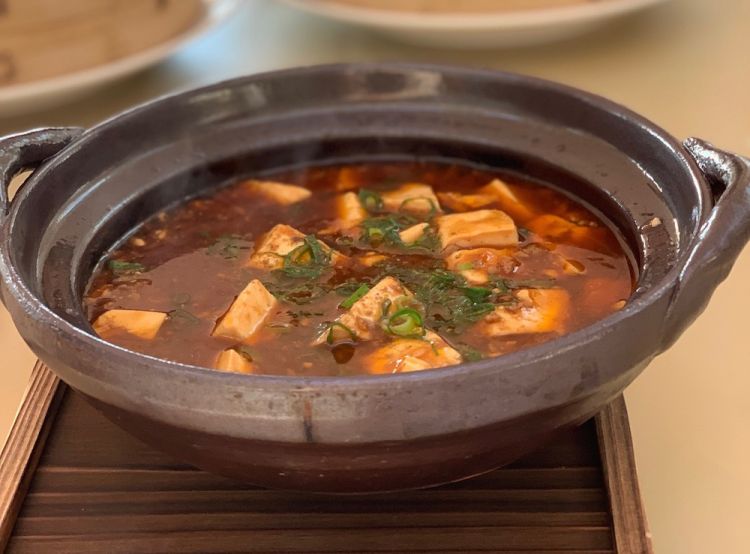
Three dishes at resort Hello Kitty Smile
In the restaurant two chefs share the kitchen. One is Japanese, the other Chinese. They are the General Producer of all of Nambu’s activities on the island, Yamashita Haru, and Chinese chef Chon Che Win. The oriental dishes we tasted were perfectly executed and served on tables with a rotating centre by a diligent and professional dining room staff. Soup of shark fins, lovely dim sums, Stewed blowfish with noodles, Prawns with onion and ginger and many more dishes, divided in different types of tasting menu or to be ordered as single courses. The luxury restaurant also has a more affordable area, bistro-style, and a café where you can taste different selections of precious Chinese tea, like the ones that have a flower blooming in the cup, with Hello Kitty-shaped biscuits, cakes and puddings.
Mr Nambu also gave life to two huge parks themed after famous, world-renown Japanese anime. The parks are built in the green heart of the island, looked after by the local administration, so they contribute to the entertainment offer. They include snack areas meant for families, where the island products stand out and you can have a picnic while sitting on the lawn.
One is the first big theme park dedicated to Naruto & Boruto, two characters who have coloured the childhood not only of Japanese children, but of all lovers of the genre; the other, Nijigen’nomori park, is instead a park with different ‘life journeys’ of increasing difficulty, for lovers of sports and physical activities, but also popular among businesses that want to create team building and recreational activities for managers and directors.
The hotel that characterises the offer that Nambu designed for this island of wonders is an extra-luxury resort made of 23 bungalows and placed on the tallest hill of Awaji: Awaji Grand Chariot 135. The 135th parallel crosses the area, so it is considered a real ‘power spot’ of natural energy. The architect who created this site designed bungalows with a circular plan, and a cone shaped roof. They are misaligned, so that every room can fully enjoy the surrounding view. All the bungalows have an equipped terrace with a view either of the hills, or of the ocean. And in the middle of the room, right above the bed, there’s a round window so you can admire the sky. The furniture, the floor and the bathroom with the traditional Japanese tub, are all made of wood. The interior design is planned in every detail, with objects and lamps that Mr Nambu has bought all around the world (he has a particularly soft spot for Italian products, like the extraordinary Murano chandeliers you can find in the Hello Kitty Smile restaurant and bar, for instance).
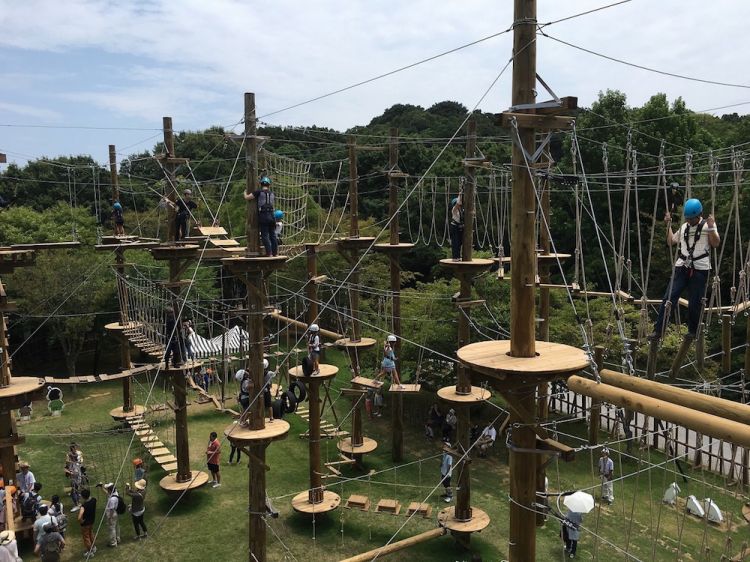
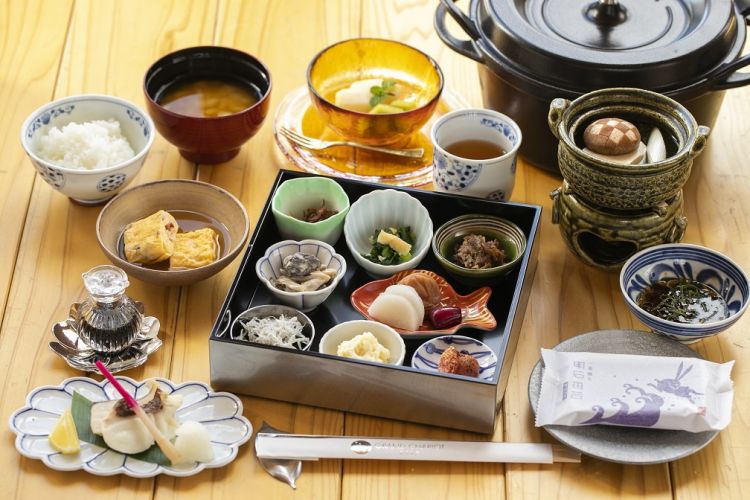
Japanese breakfast at the Grand Chariot
Here you wake up to the chirping of birds of different species, and during the night the sky turns into a blanket of stars. It’s the perfect stay for those who want to be surrounded by nature, while discovering a true Japanese breakfast. In the morning, you can book the famous breakfast made of dozens and dozens of tastings of fish, eggs, seaweeds, vegetables and local products, with the famous miso soup as well as local blowfish, baby fish and onion from Awaji. The presentation of this breakfast, with all the tableware and the small decorated plates, all selected one by one, is a real masterpiece.
Even in the evening, the Grand Chariot 135 restaurant delights its guests with traditional Japanese cuisine. In particular, we tasted the “shabu shabu” menu with local meat, Awaji Beef (known around the world as Kobe Beef). In this case the chef, always Yamashita Haru, let his creativity loose with sea urchins too, served raw and steamed.
On top of this 5-star hotel, Nambu is finalising a completely environmentally friendly resort with the help of the students of the famous Spanish architect Antoni Gaudì and of a team of young people, what with engineers and environmentalists, who for years have now been working to build rooms made of mud and earth, held together with bamboo nails. The project leader is called Daisuke Kaneko and is only 30 years old. He announced the opening of this Natural Resort called “Seed Bed” the coming March. Here guests will be able to participate in the building of their room, and make use of the vegetable garden and of the surrounding park with over 800 different varieties.
Nambu’s philosophy always starts from human resources, hence every project is thought, from the start, with a carefully selected staff that can feel a part of the project and with attention to valorising the territory. Young engineers, freshly graduated architects, but also other different professionals. The waiters you meet in the restaurants and in the hotels of the Pasona Group, for instance, are almost always creative people, actors and musicians who put their artistic skills at the service of their work, with an unusual approach. Those who serve at the tables might end the night playing the restaurant’s piano for you!
Nambu wanted to stress the features that, in his opinion, make the island unique: Awaji is in the heart of Japan, geographically, on the 135th parallel; Japanese traditional marionettes come from here; here they found the first craftwork made of wrought iron in Japan; among its agricultural products, the onion of Awaji is very famous; this is the birthplace of Kobe meat (the cattle must spend nine months on the island to be considered precious meat). Local sea urchins, blowfish, mackerel, lobster and snapper are excellent and for thousands of years here they prepared the meals for the emperor of Japan and for the imperial palace. The climate is nice, always mild, almost Mediterranean. On the island they honour the seven divinities of Fortune: the god of abundance and richness, the god of war, the goddess of beauty, of music, and of all that flows, the god of daily food, the god of good luck and of long life, and the god of happiness. And in honour of these divinities, with a successful marketing strategy, they created 7 local craft beers and 7 sakés.
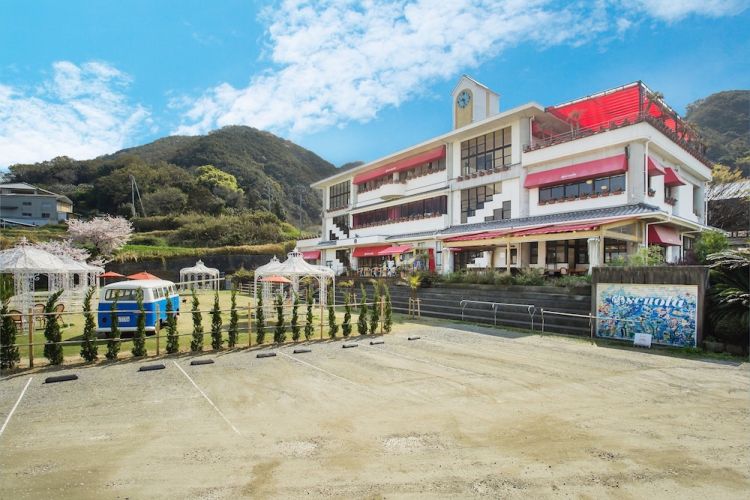
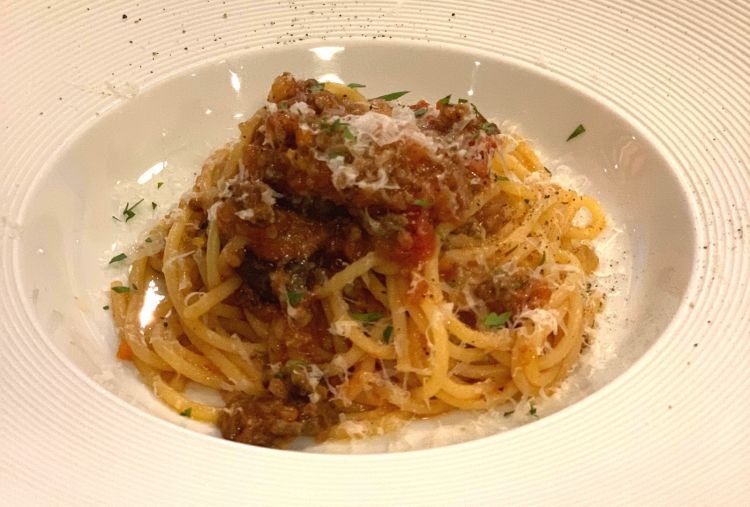
Scuola’s spaghetti with meat sauce
The second restaurant we visited was Nojima Scuola. It is named after the building where it is located and because of its remarkably Italian character. Indeed, it is an old primary school which closed in 2010. They bought it, renovated it and opened it again in 2012 as a restaurant, while preserving its original features. On top of the restaurant on the first floor, overlooking the sea, on the ground floor there’s a well-supplied supermarket where you can buy local vegetables picked on the island, baked products, including 60 different types of bread baked each day, including a rice bread with onions from Awaji. In the summer, you can eat outside in the garden in front of the parking lot, under beautiful white gazebos made with wrought iron, lit by small, warm lights.
Scuola also includes a small farm, the Nojima Zoo with two piglets, goats and two alpacas, beloved by guests, especially families with children. Raal, one of the two alpacas, only kisses ladies and is now a legend on social media. At Scuolathey serve Italian cuisine, but using local products. For instance, we had Spaghetti al ragù with meat from Awaji. As for the main courses, you can choose between fish and meat, with excellent fresh local salads on the side. The keywords chosen for this restaurant are food, nature, training and art. The motto of chef Okuda Masayuki, who studied in Italy, is “local production for local consumption" and this is why he cooks in the Italian style, with local raw materials. In the restaurant you can also appreciate the large collection of earthenware from all around the world and two models of historic cars from Italy, parked inside the restaurant.
To finish the gastronomic offer, there’s also a huge BBQ at Ocean Terrace, another restaurant that Mr Nambuwanted to create, not far from Scuola, also overlooking the sea. Here guests can choose the cut of raw meat, and cook it themselves, or attend its preparation. This is done so as to appreciate the value of the meat of Awaji, which is rare and expensive. Indeed, only 200 heads are bred on the island each year. Here at Ocean Terrace Mr Nambu managed to place a metal barbeque in the shape of a bull which can hold as much as 300 kg of meat. An interesting list of beverages includes a good selection of French and Italian red wines.
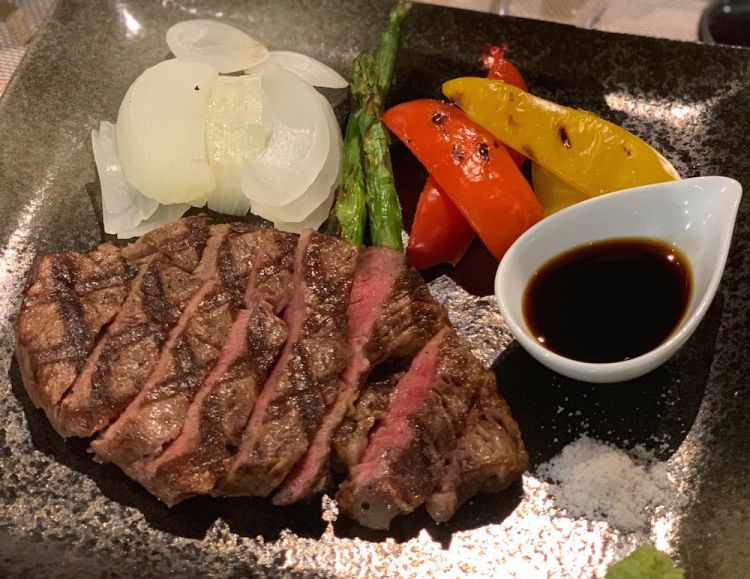
To meet the desires of pizza lovers, on the promenade they created restaurant Miele da Scuola, also inspired by Italy. Even though there’s no wood oven, pizza is loved by Japanese and tourists. At Miele the pizza is thin and crispy, a real focaccia garnished with the most typical ingredients from the island. Hence there’s the Pizza with onion from Awaji, with a mountain of fresh onions chopped on top of a base of tomato and cheese, and the pizza with baby fish, which the people of the island love to eat.
The last unusual location that we must mention is Craft Circus, a beach restaurant offering mostly street food, especially burgers and salads, with a large shop and garden dedicated to the most exotic animals, just like a circus. In this market you can buy gifts and objects from all around the world. One of the terraces of the restaurant is reserved for man’s best friend. Those who have a dog with them can enjoy a meal or an aperitif in relax.
Awaji Island is also famous for the gardens which all year round offer blooming flowers and for its vortexes of water, a phenomenon that has to do with the tides, which can be seen from the Onaruto bridge or from the beach, and can be found in many historic Japanese paintings. Because of their uniqueness, they have applied for these vortexes to be included in the Unesco’s world heritage list. To get to Awaji Island from Italy you must first fly to Osaka or Tokyo and then take two trains and a bus via Kobe. The journey is long but it’s worth it, now and especially in a few years’ time when the new ideas of this visionary man will come to life.
The island’s development project does not end here. During our visit, Nambu told us about the construction of a new port, of a large open-air spa, inspired by Roman baths. Both projects will be designed and executed by Tadao Ando, a great friend of Nambu. Indeed, the headquarters of the Pasona Group in Awaji is in one of his most famous works, because of a vertical garden with 100 modules: it’s the multi-functional Yumebutai centre, which would deserve a piece itself.
Translated into English by Slawka G. Scarso